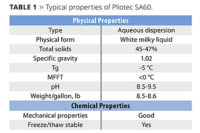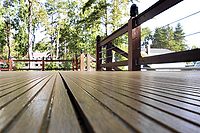Novel Waterborne Epoxy Resin Technology for Zero-VOC 2K Coatings
Waterborne epoxy coatings have evolved into two fundamentally different technologies commonly identified as Type I and Type II systems. Type I systems are based on liquid epoxy resin. Typically, the amine curing agent serves as the emulsifier for the epoxy and the emulsion is formed when the A and B components of the paint are mixed together. The more recent Type II technology uses solid epoxy resin pre-dispersed in water and co-solvent. In Type I systems, the dispersed resin particles contain both epoxy and curing agent. In Type II systems, the dispersed resin particles contain only solid epoxy resin so that the curing agent must migrate from the aqueous phase into the dispersed epoxy particles for reaction to occur. Type I systems can often be formulated to zero VOCs, primarily because liquid epoxy exhibits good handling, flow and coalescence without the aid of co-solvents. However, liquid epoxy systems cannot reach high viscosity through water evaporation alone, but must depend on chemical reaction to increase viscosity. As a result, liquid epoxy systems are very slow to dry, often taking more than six hours to reach tack free.
As mentioned, Type I systems use amine curing agents to emulsify the liquid epoxy forming dispersed resin particles, which contain both epoxy and amine. In addition, liquid epoxy (epoxide equivalent weight 190) is very rich in epoxide groups. The combination of concentrated epoxides and amine hydrogens in the same dispersed particle leads to very short pot lives.
Liquid epoxy, with its short rigid backbone, yields cured coatings with high hardness but low flexibility and low impact resistance. While suitable for cementitious applications, liquid epoxy coatings are often too brittle for use on metal substrates.
To overcome the limitations of liquid epoxy, waterborne systems based on high-molecular-weight solid epoxies were developed. Solid epoxies are supplied pre-dispersed at 50–55% solids in water and co-solvent. To aid in processing and to overcome the poor flow and coalescence of solid epoxies, 5–10% glycol ether is added to the dispersions thereby eliminating any possibility for zero-VOC formulations.
Type II systems offer the handling and performance benefits associated with solid epoxy resins. Dry times are very fast due to lacquer dry of the high viscosity epoxy. Flexibility is improved due to the more flexible backbone of solid epoxy. Pot life is much longer due to the lower concentration of epoxides and amine hydrogens, and also because amine must migrate from the aqueous phase into the dispersed epoxy particles before reaction can take place.
The principal weakness of Type II systems is their tendency to form heterogeneous films with epoxy rich and amine rich domains due to incomplete coalescence. Co-solvents and plasticizers are added at levels of 100–250 g/L to improve film formation and to extend pot life. During the pot life, as amine reacts with epoxy, the minimum film-forming temperature of the polymer keeps increasing until the film can no longer coalesce. The end of pot life is not signaled by a viscosity increase but rather by a loss of gloss or a loss of barrier properties.
Novel Epoxy Resin Technology
A novel waterborne epoxy resin dispersion has been developed that incorporates the best characteristics of both Type I and Type II systems (see Table 1). The unique chemistry of this epoxy resin enables the formulation of a Type II system that retains the advantages of such systems including high epoxy equivalent weight (EEW), long pot life and fast lacquer dry. However, coatings based on this new resin also exhibit desirable performance attributes previously only found with Type I waterborne epoxy systems, including zero VOC and lower cost-in-use.This resin, commercially known as Ancarez™ AR550 resin, exhibits the typical properties shown in Table 2 (see p. 62).
Important aspects of the Ancarez AR550 resin’s properties include its volume average diameter (Dv) of 0.5 µm, consistent with other high-quality Type II dispersions. Particle size in Type II systems is important for two reasons. First, overall particle size distribution impacts film formation, emulsion stability and emulsion viscosity. Additionally, because the curing agent must penetrate and react with the epoxy resin in Type II systems, the smaller the particle size, the greater the overall surface area of all the particles, and hence, the greater the opportunity for reaction between the curing agent and the epoxy resin.
Another important property of the resin is its molecular weight distribution. Molecular weight distribution impacts film formation, intraparticle viscosity and cure kinetics in waterborne epoxy systems. The resin contains a significantly larger percentage of lower-molecular-weight material than other established Type II solid dispersion resins. The larger percentage of low-molecular-weight material in Ancarez AR550 resin allows it to coalesce without the aid of co-solvents. Thus, the resin can be readily formulated to zero VOC while retaining the film formation characteristics of Type II systems.
Formulations Based on the New Epoxy Resin Technology
Three typical coatings were formulated to evaluate the performance of the Ancarez AR550 resin in 2K ambient-cure epoxy systems. The three coatings evaluated were a low-VOC, 4:1 anticorrosive metal primer; an ultralow VOC, 2:1 high gloss metal enamel; and an ultralow VOC, 2:1 concrete enamel (see sidebars for formulation specifics). Formulation attributes for these three coatings are presented in Table 3.Formulating Guidelines
Three important considerations when formulating waterborne epoxies are coalescence, stoichiometry and stability. As previously mentioned, good coalescence is crucial for uniform film formation and for good barrier properties. Ancarez AR550 resin exhibits very good coalescence when used with either Anquamine® 401 or 419 curing agents. To further improve properties such as gloss or pot life, aromatic epoxy diluents such as Epodil® 742 diluent (cresyl glycidyl ether) can be added to the resin at approximately 5% (w/w).When formulating for corrosion resistance, 10–40% excess epoxy is desirable. When formulating for faster property development, 10–20% excess curing agent is desirable. A good balance of properties is obtained at 1:1 stoichiometry.
Pigments and high levels of dilution can de-stabilize either the epoxy side of the formulation or the curing agent side of the formulation. When pigmenting the epoxy dispersion, a pigment dispersing agent such as Disperbyk 190 dispersant should be added to avoid agglomeration of the epoxy dispersion. When pigmenting the curing agent side of the formulation, small amounts of acetic acid (0.2–0.5% based on curing agent weight) may be needed to improve water solubility and avoid separation. This is especially true when formulating with Anquamine 419 or similar curing agents.
Handling and Performance Results - Pot Life Characteristics
All three formulations based on the Ancarez AR550 resin exhibited the desirable long pot lives of Type II systems (4–6 hours), as illustrated in Figures 1 and 2. Analysis of the viscosity development and gloss development over the induction time revealed a gradual increase in viscosity with a corresponding loss in gloss. End of pot life was shown to occur with the coating’s loss of gloss, revealing its decreasing ability to coalesce (see Table 4).
Sample Preparation
For this evaluation, the A and B components were mixed, let down with water, and spray applied to shot blasted steel (2 mil profile). The coatings (3–4 mil DFT) were allowed to cure for 14 days prior to testing. Bonderite 1000 panels were used for humidity and electrochemical impedance spectroscopy evaluation.Early Rain Evaluation
The anticorrosive metal primer, high-gloss metal enamel, and concrete enamel based on the resin were evaluated for early rain resistance by periodically applying DI water to sections of a freshly applied coating. Coatings were judged to be rain resistant when they exhibited complete resistance to blistering and softening, and only slight downglossing was observed. This evaluation revealed that after a cure of only 2–3 hours, the coatings were resistant to rain (see Table 5). Type II waterborne epoxy systems with solvent require over six hours of cure time to achieve an equal degree of rain resistance.
Other Performance Characteristics
Standard performance evaluations including pencil hardness, Persoz hardness, dry and wet adhesion, humidity resistance, salt fog, flexibility, and direct and reverse impact resistance were also conducted on the anticorrosive metal primer, high-gloss metal enamel and concrete enamel formulations. Results from these tests (summarized in Tables 6–8) show that all three formulations based on the resin deliver equal or superior performance characteristics, as compared to conventional solid resin dispersions, however at ultra-low VOC and a lower cost-in-use.
Performance Evaluation Using ElectroChemical Impedance Spectroscopy
EIS is a relatively new technique for measuring the barrier properties of coatings. EIS experiments are typically 24 hours in duration and correlate well with long-term tests such as salt fog and prohesion.As shown in Figure 3 (p. 68), EIS involves exposing a coated steel panel to a salt water solution. A small AC voltage is applied to the steel panel. The electrical current that passes through the coating into the salt water is measured. By varying the frequency of the AC voltage, it is possible to separate and measure the water uptake of the coating (capacitance) and the resistance of the coating to sodium and chloride ion penetration (pore resistance).
Resistance (Log Modulus [ohm]) is graphed vs. frequency to obtain a plot that measures both water uptake at high frequency and ion resistance at low frequency. A good barrier coating will exhibit low water uptake and high resistance to ion penetration, as illustrated in Figure 4 (p. 68).
Experimental Results
The anticorrosive metal primer, high-gloss metal enamel and concrete enamel were each spray applied (3–4 mil DFT) to shot blasted steel panels (2 mil profile). Using a Gamry FAS1 Potentiostat with EIS 900 software, measurements were taken after 1 hour of immersion in 1 M NaCl solution for all three formulations.EIS results (see Figure 5) indicate that all three formulations showed very good resistance and capacitance (greater than 106 ohms) after 1 hour immersion. This data indicates that the coatings are highly resistant to ion penetration, particularly in the case of the anticorrosive metal primer and high-gloss metal enamel, where such properties are extremely desirable.
A comparison of the extent of cure was also undertaken using EIS to evaluate the metal primer’s corrosion resistance. For this evaluation, the metal primer formulation based on the resin was applied to 3–4 mil DFT over shot blasted steel (2 mil profile). Separate panels were cured over seven and 14 days, and then evaluated, again using the Gamry FAS1 Potentiostat with EIS 900 software. Measurements were taken after one hour and 24 hours immersion in 1 M NaCl solution.
EIS results indicate that after a one-week cure, the metal primer coating is very highly resistant to salt water (as measured by the y-axis). Panels cured for two weeks show an even greater resistance to ion penetration, demonstrating the anticorrosive properties of the Ancarez AR550 resin-based metal primer formulation.
Summary
A novel waterborne solid epoxy resin designed for two-component, ambient cure epoxy systems displays the desirable characteristics of both Type I and Type II systems. Typical industrial-maintenance coatings formulated with the resin were shown to deliver equal or superior performance characteristics, particularly early rain resistance, as compared to conventional solid resin dispersions, however at ultralow VOC and lower cost. Based on the performance evaluations that were conducted, recommended applications include OEM, industrial-maintenance and transportation coatings; floor sealers and paint; anticorrosive primers, mid-coats and top coats; and industrial coatings.
For more information on this resin and other technologies, contact Air Products and Chemicals Inc. at 7201 Hamilton Blvd., Allentown, PA 18195-1501; phone 800/345.3148; fax 610/481.4381; visit www.airproducts.com/epoxyadditives; e-mail info@apci.com.
Links
Looking for a reprint of this article?
From high-res PDFs to custom plaques, order your copy today!





